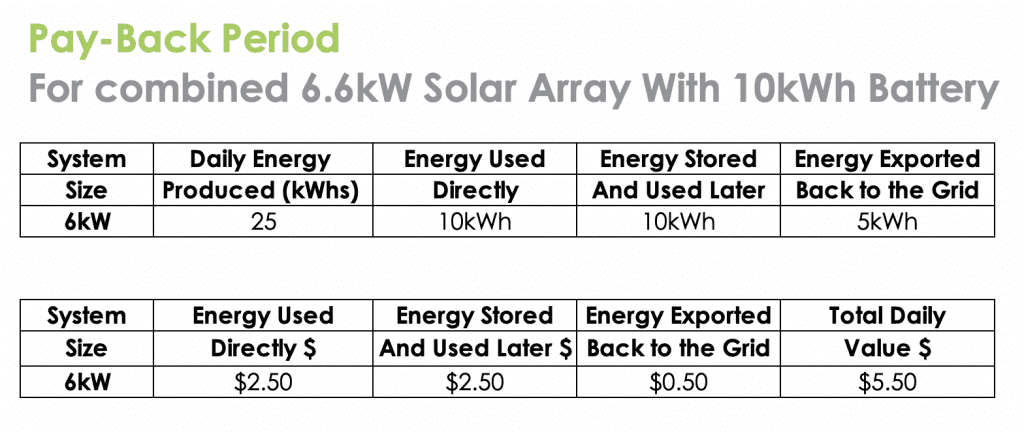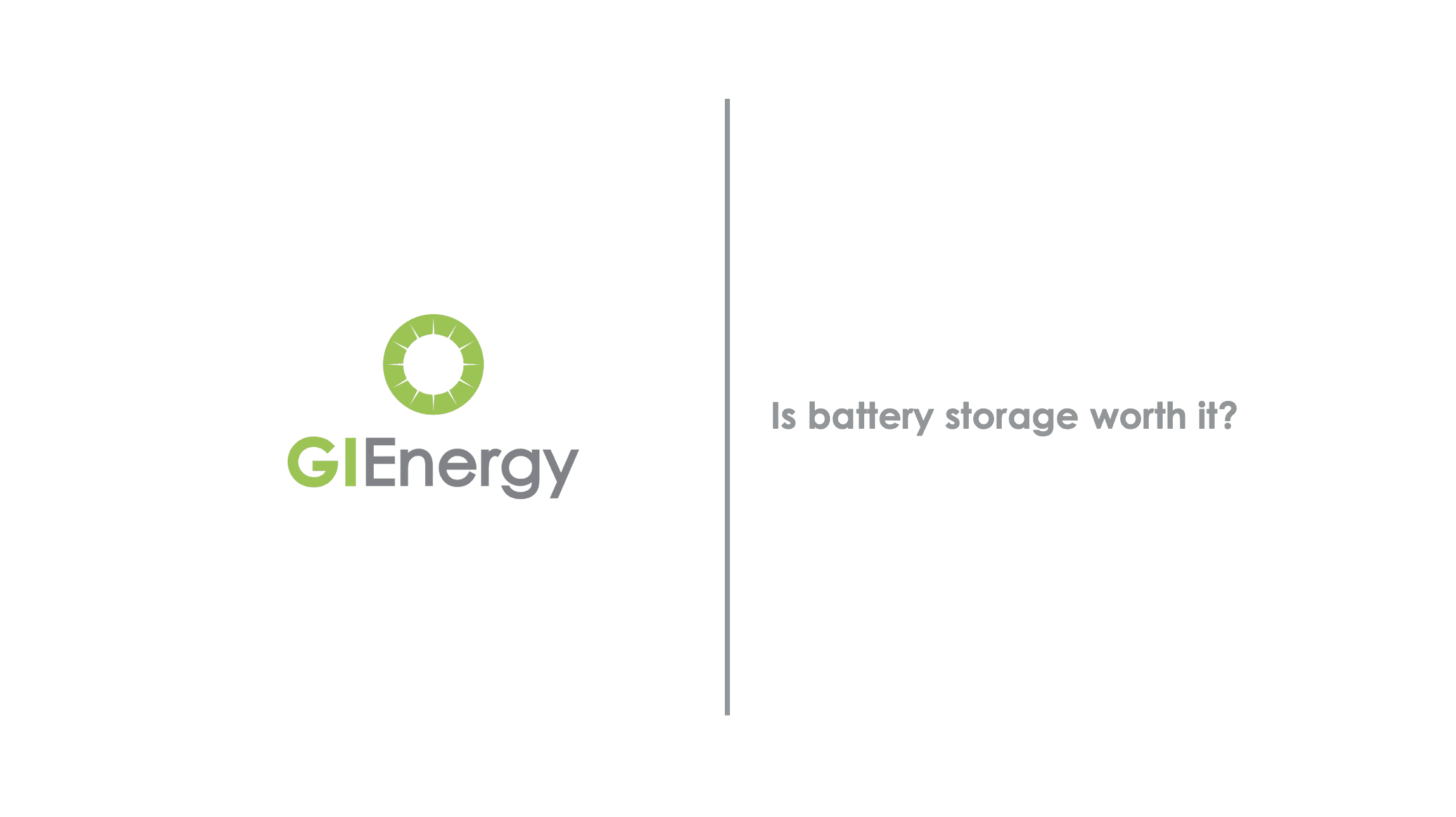Is it worth getting solar batteries? What are the benefits of battery storage?
This question wins the award for the fastest growing solar query in recent times. It has become quite rare for people not to ask this question. So much so, that often we find ourselves addressing it before the words even leave the lips of the customer we are talking to.
So, is solar battery storage worth it? Or shall I continue to wait?
Battery storage is worth it if you do not mind a longer payback period as a solar install with no battery will usually pay for itself quicker!
At GI Energy we installed over 400 solar systems with batteries last year. We have also sent over 400kWhs of battery storage to Papua New Guinea to be installed in a remote village called Telefomin. From time to time we also install small off-grid systems for customers. We have been doing this since 2011 so we have lots of experience and we understand the pros and cons of solar batteries very well!
What is the primary reason for considering a battery?
If the answer here is “purely for financial reasons” then more often than not, the battery part of your solar system is difficult to justify. Once your solar system is installed, you will either use the energy you produce, or you will export it back to the grid. The electricity you use, is worth more than the electricity you export back to the grid. See solar for beginners for more information. The table below shows how much your solar energy is worth if you use it, vs. exporting it back to the grid.

You can see form the table that when you use the solar electricity it is worth quite a bit more than if you export it.
So, if you can store the electricity in a battery and use it later, instead of exporting it back, then adding a battery will save you more money! But how much more?
The easiest way to think about this is by breaking it down to how much added value you can get from each kWh of solar produced. To understand more about kWhs and how your energy bills works, click here. In the table above we have assumed a purchase price of electricity at $0.25 Inc. GST and an export rate of $0.10 Inc. GST. Using these numbers, the added value you get from each kWh of solar produced by storing it in a battery is $0.15. This is because you have not exported the energy and received $0.10, but instead stored it and used in later which has saved you $0.25.

So, if the added value of a battery is $0.15 per kWh, how long will it take to pay the battery off?
Installing a battery will cost approximately $800 per kWh of storage. At $0.15 of added value per kWh using a battery, this means you will need to store and use 53,333kWhs to pay for each kWh of battery you have installed.

So, we now know you would need to produce and store 53,333kWhs of solar to pay for each kWh of battery installed. Next, we can work out how long that will take.
As you can see from the table above, it will take approximately 11.69 years to return the outlay on the battery component of your solar system alone.
The tables above illustrate how the financial return works on the battery alone. When purchased with a solar array, the return on investment is much better. This is because the solar panels are heavily subsidised by the Government, and when you blend the investment together (solar panels and batteries installed together) it makes much more sense.

As you can see from the table above, the combined potential value for a 6.6kW solar array purchased with a 10kWh battery is $5.50 per day. The typical cost of a good quality 6.6kW solar array with 10kWhs of battery storage is approximately $15,000.
This means a total potential saving of $2007.50 per year, which is 7.4-year payback period – much more acceptable than 11.69 years when considering the battery component alone. Purchasing a solar array with no battery will of course create a financial return of approximately 4-years, which is even better again!
It is also worth noting here that in some areas you will not be allowed to export anything to the grid. The calculations above have assumed a $0.10 feed in tariff, which is only available if you get export approvals from the network owner. If you do not get approvals to export energy, then a battery becomes more viable again. The feed in tariff also varies in different locations, so $0.10 has been used as an example only.
There are also lots of other benefits associated with installing a battery system, so basing your decision on the financial return alone, doesn’t paint the full picture.
What about protection from black outs / power cuts?
This is probably the second key benefit after saving money associated with solar panels and batteries. Especially for people in areas where power cuts are common. Using the above example of the 10kWhs of battery storage, you can supply power to essential loads like lighting, fridges and power points for charging phones and computers for a decent period of time. While this is a very handy feature it must be noted that a 10kWh battery is not going to work for long if you use things like air con, pool pumps hot water elements or other high-power consuming appliances.
If you are choosing a battery and this is one of your primary needs, please make sure you check that the battery you are buying is capable of delivering what you need when the mains power does fail. Not all battery systems are the same and some will deliver much better results for emergency power supplies than others.
Maximising your Co2 reduction
Another benefit of installing battery storage is the environmental aspect. The financial return may not be as good as buying a solar array with no batteries, but the environmental impact is greater. So, for those who are looking at their carbon footprint as well as their bank balance, batteries can offer another benefit here.

This is especially true for people who are not allowed to export energy back to the grid. Throughout this article we have used an example feed in tariff of $0.10 – which is a reasonable average across Australia. However, in places where grid infrastructure is poor, or solar uptake has been very high, you may not be allowed to export anything back to the grid. This means your system will be export limited, so if you are not using all the potential solar power during the day, it won’t be exported to the grid at all. This means you will have lots of “wasted” power than can’t be used or exported. Having a battery in place will mean this energy is not wasted.
If you can export energy back to the grid, there is still some wastage here as the electricity being exported and reused is not 100% efficient and creates more electrical losses than storing it in a battery and using it later.
Why else do people buy batteries?
As mentioned previously we do sell a lot of batteries at GI Energy. The list below are some other reasons people have given us for buying batteries over the years:
- Early adopters – people who love new technology and want the newest and best installed at their home.
- Stick it to the energy company – people who do not want to pay big energy companies and are not worried about a longer payback period as long as they reduce their bills as much as possible.
- Keeping up with the trends – all my friends have a battery, now I want one!
- Investment homes – when people are building high-spec homes to sell, they often want to include a solar and battery system to keep in line with the premium design of the home.
Summary
If you are considering a solar and battery system and basing your decision on the financial return alone, then you should probably wait until the cost of batteries comes down. If you are considering a battery for environmental reasons, or for emergency power supply during power cuts then it will be worth considering further.
Here are some other helpful links:












